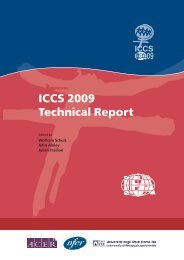Teacher Education and Development Study in Mathematics - IEA
Teacher Education and Development Study in Mathematics - IEA
Teacher Education and Development Study in Mathematics - IEA
You also want an ePaper? Increase the reach of your titles
YUMPU automatically turns print PDFs into web optimized ePapers that Google loves.
146<br />
TEACHER PAY AND STUDENT MATHEMATICS ACHIEVEMENT<br />
Spa<strong>in</strong><br />
Composition of the teacher labor force<br />
Accord<strong>in</strong>g to the Anuario Estadístico de España 2007 (Statistical Yearbook of Spa<strong>in</strong>, 2007),<br />
published by the National Institute of <strong>Education</strong> (2007), the number of students enrolled<br />
<strong>in</strong> Spanish primary schools (both public <strong>and</strong> private) decl<strong>in</strong>ed slightly between the mid<br />
1990s <strong>and</strong> 2004/2005, from about 2.6 million to 2.5 million. Enrollments rose a little<br />
<strong>in</strong> basic- <strong>and</strong> upper-secondary schools. The number of classroom teachers <strong>in</strong>creased<br />
considerably, especially relative to the number of students. Between the mid 1990s <strong>and</strong><br />
2004/2005, the number of teachers <strong>in</strong> non-university public schools <strong>in</strong>creased by nearly<br />
19%. These changes resulted <strong>in</strong> reductions <strong>in</strong> student–teacher ratios <strong>in</strong> preschools <strong>and</strong><br />
<strong>in</strong> primary <strong>and</strong> secondary schools <strong>in</strong> Spa<strong>in</strong>. Additionally, between the 1994/1995 <strong>and</strong><br />
the 2004/2005 school years, the number of young people enrolled <strong>in</strong> teacher preparation<br />
programs <strong>in</strong> Spa<strong>in</strong> <strong>in</strong>creased from 68,748 to 95,550 (M<strong>in</strong>istry of <strong>Education</strong> <strong>and</strong> Science,<br />
2004).<br />
In 2005, about 70% of all primary teachers were women, as were 56% of secondary<br />
teachers (Eurostat, 2008). Between 1990 <strong>and</strong> 2001, the percentage of female students<br />
enrolled <strong>in</strong> primary teacher preparation programs <strong>in</strong>creased from 40.8% to 73%. The<br />
relative percentage of females graduat<strong>in</strong>g from these programs was even greater than<br />
the percentage enrolled, <strong>in</strong>dicat<strong>in</strong>g not only that more females than males study to be<br />
primary teachers, but also that females are more likely to complete their programs of<br />
study. At the secondary level, a much larger proportion of female teachers than male<br />
teachers participates <strong>in</strong> the year-long pre-service course. In 2001, for example, females<br />
made up 80% of all students <strong>in</strong> these courses. Moreover, the number of females <strong>in</strong><br />
secondary pre-service courses <strong>in</strong>creased by 22% between 1995 <strong>and</strong> 2001. The number of<br />
males study<strong>in</strong>g to be secondary teachers <strong>in</strong>creased by just over one percent (Sanz Vallejo,<br />
Ortiz Gordo, & Álvarez Prieto, 2003). These trends <strong>in</strong>dicate a grow<strong>in</strong>g fem<strong>in</strong>ization of<br />
both the primary <strong>and</strong> secondary teacher workforces <strong>in</strong> com<strong>in</strong>g years.<br />
In terms of the academic backgrounds of secondary education teachers, prospective<br />
teachers tend to come largely from the humanities <strong>and</strong> social sciences. In 2001, nearly<br />
9.5% of students enrolled <strong>in</strong> secondary pedagogical aptitude courses had degrees <strong>in</strong><br />
foreign languages, more than 17% had backgrounds <strong>in</strong> geography <strong>and</strong> history, <strong>and</strong><br />
nearly 19.5% had degrees <strong>in</strong> language. In contrast, a little over eight percent had degrees<br />
<strong>in</strong> mathematics <strong>and</strong> just over seven percent had degrees <strong>in</strong> physics <strong>and</strong> chemistry (Sanz<br />
Vallejo et al., 2003).<br />
Two f<strong>in</strong>al features of the teacher workforce <strong>in</strong> Spa<strong>in</strong> are its relatively low attrition rate <strong>and</strong><br />
its limited mobility. In the five years before 2003, only about one percent of the public<br />
school teach<strong>in</strong>g staff left public school teach<strong>in</strong>g. Workers <strong>in</strong> the education sector also<br />
rema<strong>in</strong>ed <strong>in</strong> their profession longer than workers <strong>in</strong> most other sectors. Additionally,<br />
most teachers who left the profession did so because of retirement or ill health. Only<br />
<strong>in</strong> rare cases did teachers apply to permanently leave the profession. Also, although<br />
approximately 25% of public school teachers applied for school transfers dur<strong>in</strong>g the<br />
five-year period, fewer than one-third of these teachers were granted their requests<br />
(Sanz Vallejo et al., 2003).

















